July 15, 2025
7 Essential Strategies for Hiring, Developing, and Retaining AI Talent
AI talent is scarce, expensive, and increasingly critical to organizational competitiveness. As demand outpaces supply, University Recruiting teams face growing pressure to identify, attract, and retain top researchers, engineers, and applied scientists.
This guide outlines seven strategies drawn from employer case studies, academic partnerships, and candidate insights to help recruiting teams compete more effectively in today’s high-stakes AI hiring landscape.
The State of the AI Talent Market
PhD-level AI and machine-learning talent remains one of the most constrained segments in technical hiring. Although the number of newly awarded AI PhDs in the U.S. and Canada has roughly doubled since 2020, the pool of new talent still amounts to only a few hundred per year compared to thousands of open roles.
The demand for new AI hires is increasing further. According to Veris Insights Research, AI job postings on LinkedIn have jumped 50%, fueled by C-suite initiatives to acquire “skills of the future” and develop internal AI capabilities. CEOs such as Mark Zuckerberg and Sergey Brin now personally reach out to top candidates, and Wall Street banks routinely offer data scientists and ML engineers six-figure salaries. Despite generous offers, compensation alone doesn’t always secure the best talent.
Broader education trends further illustrate the supply-demand mismatch: Bachelor’s degrees in AI programs have surged over 500% since 2019, and Master’s degrees are up over 880%, yet Doctoral-level AI degree conferrals have declined 26%. These trends make it clear that true research specialists remain exceptionally scarce, and competition for them grows increasingly intense.
Many AI candidates fall into distinct personas. Some prioritize autonomy, others seek real-world impact, and many value collaborative, cross-functional teams and environments. Roles should be tailored to these preferences, not just in messaging but in actual structure and day-to-day work.
Furthermore, timing matters as much as personalization. The ideal window to recruit PhDs opens right after their academic hiring cycle, and visibility at flagship conferences like NeurIPS or ICLR can tip the balance in your favor.
Understanding the Core Profiles for AI Talent
Our interviews with postdoctoral scholars and late-stage PhD students revealed five distinct personas. Each brings unique priorities and decision drivers. Designing your roles and outreach around these can boost engagement and conversion.
Self-Directed Researcher
These candidates are motivated by intellectual freedom and want to chart their own course. They seek roles that allow them to define the problems they pursue, select their tools and methods, and work without constant oversight, much like in academia.
To appeal to this persona, employers should emphasize:
- Flexibility in project selection: Freedom to identify and pursue novel problems relevant to your business.
- Autonomy in problem-solving: Control over how to approach challenges, including choosing frameworks or building new algorithms rather than tweaking existing ones.
- No micromanagement: Minimal supervision of day-to-day tasks, as long as high-level goals are met.
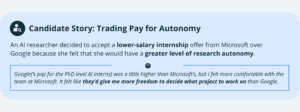
Skill Gardener
These are growth-minded researchers who seek out new skills and domains that stretch their capabilities. They look for roles that expand their technical toolkit, expose them to diverse applications, and invest in both formal and informal learning.
To engage this candidate type, highlight:
- Access to diverse tools and frameworks: Hands-on experience with cutting-edge platforms alongside industry staples.
- Broader scope of work: Cross-disciplinary projects (e.g., ethics, sustainability, robotics) that stretch beyond narrow AI tasks.
- Formal and informal learning opportunities: Structured workshops, bootcamps, and peer-to-peer “dev teach-ins.”
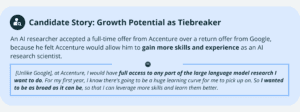
Real-World Changemaker
Driven by impact, these researchers want their work to solve meaningful, concrete problems that contribute to the greater good. They’re often willing to trade top-of-market pay for roles that have clear, measurable outcomes in areas like healthcare, education, or renewable energy.
To engage this persona, emphasize:
- Opportunities to solve real-world problems: Roles focused on tangible solutions rather than abstract challenges.
- Alignment with personal passion and values: Projects that advance missions candidates care deeply about.
- Ability to make a positive impact: Chances to see research translated into products or policies that benefit society.
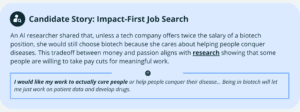
Balance Seeker
These candidates value a supportive culture, a sustainable pace, and genuine work-life balance. They often rule out roles with high burnout risk and are quick to dismiss employers known for long hours or pressure-driven environments, regardless of compensation. Benefits like generous leave policies and flexible work arrangements
To appeal to this persona, highlight:
- Cultural norms respecting work-life balance: Policies discouraging after-hours emails and meetings.
- Generous paid time off & leave: Sabbaticals, parental leave, mental-health days, and similar benefits
- Flexible work hours and modalities: Ability to set daily schedules and blend remote/in-office days
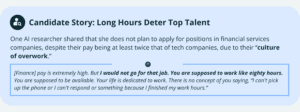
Synergy Scout
These team-oriented researchers thrive in collaborative, impact-driven environments reminiscent of academic labs. They look for teams where knowledge-sharing is the norm, mutual learning is expected, and shared success is valued as highly as individual contribution. They’re energized by co-authoring papers, building together, and contributing to research communities, not just completing assigned tasks.
To attract this persona, highlight:
- Expertise on the team: Working alongside colleagues with deep knowledge across AI subfields.
- Opportunities for mutual learning: Regular journal clubs, workshops, or peer-led “teach-ins.”
- Synergetic teamwork & shared goals: Cross-functional projects that culminate in co-authored papers or new product launches.
- Easygoing, cooperative teammates: A lab-style culture where everyone pitches in and supports one another.
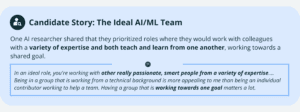
Strategies to Attract and Retain Top AI Talent
Building a best-in-class AI recruiting program means going beyond generic job ads that rely on brand power or top-market pay. It calls for deliberate, research-aligned strategies that reach candidates early, build trust over time, and reflect how technical researchers evaluate opportunities.
The following tactics help you meet PhD researchers where they already are, engage them more effectively, and convert top candidates into team members.
Recruiting Talent at Academic Conferences
Academic conferences are a cornerstone of the AI research ecosystem. They’re where PhD candidates present new work, connect with peers, and explore future career paths. For employers, these settings offer a unique opportunity to engage top talent in a way that feels authentic, technical, and relationship-driven.
What sets conferences apart is their ability to build trust early. Candidates observe your researchers presenting, attend your sessions, and engage in low-pressure conversations that reveal what it’s like to work on your team.
To maximize impact:
- Have incumbent AI researchers present their latest papers: Visibility on technical stages signals credibility and sparks organic interaction.
- Pair recruiters with technical team members: Peer-led outreach increases response rates and allows for deeper conversations.
- Sponsor targeted events: Workshops and roundtables align your brand with meaningful work and a sense of collaboration.
For stronger follow-up:
- Identify presenters in advance and send personalized outreach.
- Capture interest on-site through QR codes or sign-up forms to build your talent community.
Academic conferences create a shared context that can be the difference between an ignored email and a candidate who’s ready to engage.
Reaching PhDs on Campus Through Seminars and Networking
On-campus events offer a powerful way to engage PhD candidates before they formally enter the job market. These touchpoints allow you to showcase your research culture in an academic setting, helping to build familiarity and credibility early.
What makes this approach effective is its ability to lower the stakes. When candidates can meet researchers informally and observe how your team thinks, they’re more likely to picture themselves succeeding in your work environment.
To execute this strategy well:
- Host research seminars: Invite your PhD-level scientists, ideally alumni or former postdocs at the host institution, to present recent work and field questions about how they apply academic training in industry, and what it’s like to collaborate in a cross-functional environment. This line of questioning helps candidates understand both the nature of the work and the culture behind it.
- Organize approachable networking events: Keep these events optional and clearly structured to lower barriers. Offer multiple participation paths, such as informal Q&A or small-group breakouts, and avoid requiring resumes or advance registration. The goal is to make early engagement feel accessible, not evaluative.
- Follow up with intent: After the event, send tailored follow-ups, like session recordings, opportunities to apply for internships, or check-ins, to continue the relationships and lay the groundwork for future engagement.
With these practices, the goal isn’t to drive immediate applications; it’s to give candidates a reason to remember you when they make their final decision.
Invite AI PhD Talent to Journal Clubs
Journal clubs function as low-cost, low-pressure “talent testers” for AI PhD candidates while signaling that you value deep academic training. By inviting researchers to engage in discussion, not just evaluation, you create space for mutual learning, early relationship-building, and subtle talent assessment.
To run journal clubs effectively:
- Invite local PhD students or postdocs: Focus on individuals who’ve published work relevant to your team’s domain, methodology, or mission. Frame the event as community-building, not recruiting, to build goodwill and trust.
- Have your researchers host the session: Rather than leading it top-down, let the guest researcher walk through their work, then facilitate discussion with your internal team. This creates space for both sides to engage as equals.
- Close with casual connection: Follow the session with a team-sponsored dinner or coffee meetup. These informal moments often reveal more about fit—on both sides—than any formal interview.
This will help you build credibility by showing, not just saying, what your organization values. They create opportunities to engage with candidates in ways that reflect your research culture, making it easier to connect with those who share similar priorities.
Source AI PhD Researchers Beyond Computer Science
Many of the most innovative applications of AI are emerging outside of computer science (CS) departments. As AI becomes more embedded in domains like healthcare, climate science, and neuroscience, the researchers driving meaningful breakthroughs are often trained in adjacent fields, bringing with them deep subject-matter expertise and highly transferable technical skills.
Broadening your sourcing strategy beyond CS programs helps find researchers who’ve already applied AI to real-world problems—and can thrive in industry settings where context matters as much as code.
Key fields to explore include:
- Bioinformatics & Computational Biology: Machine learning applied to genomics and protein folding.
- Neuroscience & Cognitive Science: Expertise in neural data modeling, behavioral prediction, and decision-making simulations.
- Climate Science & Robotics: Focus on environmental modeling and autonomous systems.
- Statistics, Mathematics & Electrical Engineering: Strong foundations in algorithm design, signal processing, and data theory.
- Medical Informatics & Data Science: Research experience in EHR analytics, diagnostic models, and predictive health tools.
Researchers from these domains often bring a hybrid mindset: fluent in both technical implementation and problem framing. That combination can be especially powerful for organizations looking to deploy AI in highly specialized or regulated environments.
Build Relationships Between Researchers
PhD candidates want to know their expertise will be respected, their growth supported, and their colleagues equipped to engage at a high technical level. That’s why peer-to-peer interactions, with researchers who’ve made the same transition, are so effective.
These conversations help candidates visualize daily life on your team. They build trust, surface real insights, and reduce uncertainty in ways formal interviews can’t. When candidates hear directly from someone who shares their academic background, the connection feels more credible and more convincing.
To make these connections meaningful:
- Involve PhD-level scientists in interviews: Ensure they share similar or complementary research backgrounds.
- Host informal dinners: Small-group meals with incumbent researchers let candidates assess cultural and technical fit.
- Offer post-offer connections: Give new hires the chance to chat with future teammates before their start date.
In an environment where every offer counts, peer relationships offer an edge. They show that your company doesn’t just hire researchers—you understand them.
Use Fellowships to Build Prestige and Pipelines
Competitive, research-oriented fellowships signal that your company is more than a hiring destination. They show that you support original thinking, trust early-stage researchers, and create space for meaningful, independent work.
Fellowships also build early access. By funding and mentoring promising talent before they enter the full-time job market, you gain insight into their research, develop personal rapport, and shape their view of your organization well before a formal offer is on the table.
To build an effective program:
- Offer high-reward fellowships: Support all-but-dissertation (ABD) PhDs with funding, mentorship, and freedom to pursue novel research.
- Promote the prestige: Highlight fellowship winners on your website and at academic events to build recognition.
- Convert fellows into full-time employees: Many fellows already have context, relationships, and aligned priorities, allowing them to transition seamlessly into research scientist roles after graduation.
Fellowships help position your organization as a place where serious researchers can thrive. At the same time, they strengthen your long-term pipeline with candidates who already know and trust your team.
Create Partnerships with University Labs
Long-term collaborations with university research labs help organizations maintain a respected, consistent presence in the academic ecosystem. These partnerships offer more than access to talent. They reinforce your credibility, support co-innovation, and build familiarity with emerging AI researchers over time.
What sets lab partnerships apart is their continuity. Rather than relying on one-time recruiting touchpoints, you build ongoing relationships through shared research agendas, co-authored work, and repeat engagement with both faculty and students.
To structure these partnerships effectively:
- Sponsor research or fellowships tied to lab priorities: Identify programs where your research goals align and offer targeted funding, mentorship, or project support.
- Enable co-publication and shared IP ownership: Joint research strengthens your reputation as a peer, not just an employer, and brings visibility to your team’s technical contributions..
- Keep your researchers engaged: Encourage your PhD-level employees to remain involved with academic networks through talks, collaborative projects, and mentorship.
Strong lab partnerships generate a virtuous cycle. As your researchers stay connected to academic peers, your organization earns referrals, early access to talent, and long-term credibility within top research communities.
Case Studies: Building AI Talent Pipelines in Practice
Leading tech employers are increasingly investing in long-term academic partnerships to engage PhD candidates well before the traditional recruiting cycle begins. The two examples below illustrate how companies can create structured, mutually beneficial programs that both support research and build lasting talent pipelines.
Amazon & Columbia University
Amazon teamed up with Columbia’s School of Engineering to launch the Columbia Center for Artificial Intelligence Technology (CAIT). The program blends academic research with hands-on industry immersion to engage PhD candidates early and build long-term alignment between research interests and business needs.
Through CAIT:
- Amazon and Columbia research scientists co-host workshops, seminars, and dedicated recruiting events.
- PhD students receive funding for independent projects, developing new AI algorithms tailored to Amazon’s needs
- Participants simultaneously join as paid interns, gaining practical experience while building familiarity with Amazon’s tools, culture, and technical priorities.
This dual structure delivers immediate business impact through applied research while creating a rich pipeline of candidates already familiar with Amazon’s tools, culture, and research priorities.
Meta’s Visiting Researcher Program
Meta partners with four top U.S. PhD programs—Washington, CMU, Berkeley, and NYU’s CIMS/CDS—to offer a Visiting Researcher AI Mentorship Program. Participants work part-time during the academic year and full-time over the summer at a nearby Meta office, engaging in industry-specific projects and networking with Meta researchers.
By targeting students before they enter the full-time job market, Meta gains a first-mover advantage, builds brand affinity, and shapes its future talent pool with candidates already versed in Meta’s research challenges.
Positioning Your Company as an AI Talent Magnet
Becoming a destination for top AI PhD talent means demonstrating that your organization understands how researchers work, what they value, and how they grow. That’s where personalized outreach, thoughtful role design, and peer-to-peer engagement make the difference.
By aligning your strategy to the five core personas—Self-Directed Researchers, Skill Gardeners, Real-World Changemakers, Balance Seekers, and Synergy Scouts—you can build a talent experience that resonates well beyond the offer stage.
For additional impact, involve your current PhD-level researchers in every step, from initial outreach to informal dinners. Their presence reinforces your organization’s credibility, signals respect for academic training, and gives candidates a clear picture of what it looks like to grow and succeed on your team.
In a market where compensation alone rarely wins, it’s personalization and authentic connection that set employers apart. These strategies not only improve conversion, they position your organization as a center of innovation and a long-term home for research-minded talent.
Ultimately, building credibility, alignment, and trust at every stage of the candidate journey is what separates good recruiting from lasting impact.
